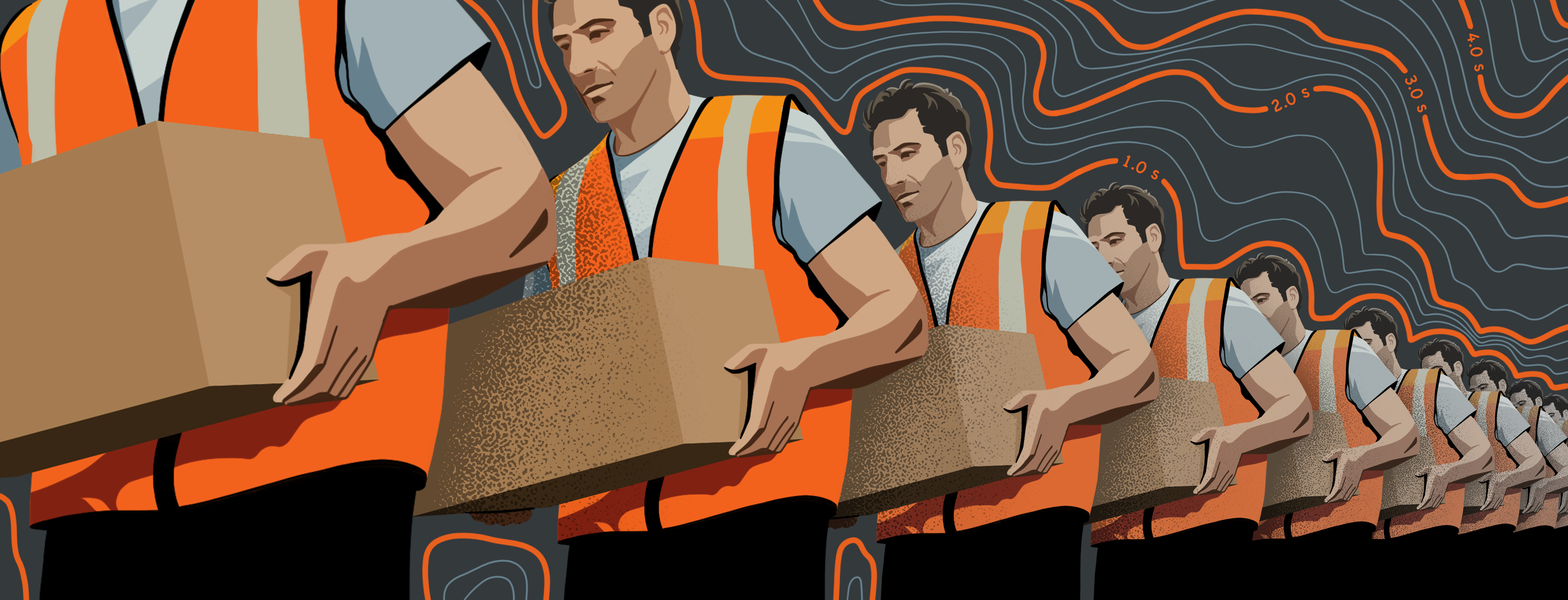
A Time & Motion (T&M) study can be a valuable addition to a user-centered design process. Time & Motion studies are usually conducted to identify potential bottlenecks in productivity but can also identify physiological risks associated with working in a warehouse environment, factory, health care environment or lab setting. Significant enhancements in productivity have been linked to ergonomically designed workspaces, leading to better worker morale and increased revenue due to reduced cycle times and fewer repetitive stress injuries.
At Kaleidoscope, we perform several time & motion studies for our clients every year. One of the advantages of this research technique are the insights gained by observing actual users performing the workflow in context and in real time. Our process for conducting a T&M study usually follows this sequence:
- Meet with stakeholders to define the target users and workflow, and to determine if user experience and motion data will be in scope. If motion data is required, collaborate with ergonomic engineers to coordinate efforts.
- Schedule onsite data collection. Send enough researchers to collect observational data, operate recording equipment, and conduct contextual interviews with participants.
- Extract data from video footage through frame-by-frame video manipulation. Analyze data, conduct descriptive statistical analysis and inferential analysis when appropriate. Identify insights and themes relevant to the research question(s).
- Synthesize and present results to stakeholders. When possible, compare current results with historical data to view changes in time requirements that could be related to workspace/workstation design improvements. Incorporate user experience findings to give research participants a voice in future workstation design changes and continue Kaleidoscope’s commitment to human-centered design and research.
WHAT IS NOT MEASURED IN A TIME & MOTION STUDY
Time and motion studies are ideal for identifying productivity obstructions and potentially unsafe body movements. Not all the important factors related to employees’ work experiences are measured, however. As technology and infrastructure become more robust and complex, we have responded by expanding our capabilities to provide value for our clients. We share one challenge here to illustrate the complexity of studying modern warehouse environments.
Challenge
- Time studies often target one piece of a complex system.
- When only one component of a facility/system is studied, external factors that influence time requirements may not be observable or included in data collection.
- Changes made to the target component may create unanticipated changes elsewhere in a facility or system.
- Factors out of employees’ control may be misinterpreted as inefficiency.
Potential Solutions
- It may be helpful to apply systems thinking near the beginning of a time & motion project.
- Consider the larger system structure within which the T&M study is taking place.
- Document who may be influenced by the design or redesign of the target component.
- Discuss what stakeholders prioritize that could be influenced by the redesign of the target component.
- Consider whether there are opportunities to change the system structure.
- At what points can we intervene?
- If possible, design interventions that benefit the entire system.
- Map the system, even parts outside the area of focus. Create a visualization that allows stakeholders to envision how the system might react to changes in its structure (e.g., process map, schematic illustration, storyboard, animation).
Potential Add-Ons
To maximize the human potential embedded within workplaces, other research techniques may be added to time & motion studies for an even greater degree of comprehension.
- Visual Aids: Diagrams of the facility the study is based on may help the audience better understand research findings.
- Surveys: Surveys provide an inexpensive method of gathering large amounts of data quickly. Often, responses are provided in numeric format which allows for historical comparisons.
- Interviews: 1:1 or group interviews may be added to a time & motion study to gain an understanding of time requirement results. Contextual information known to participants but not researchers may be shared in an interview to provide a deeper understanding of the “why” behind observed time requirements.
THE HUMAN COST OF EFFICIENCY IMPROVEMENTS
Any improvements to efficiency should be weighed against the human cost to the workers employed in the facilities we study. If efficiency improvements create a stressor where none was present, carefully consider whether the cost is worth the price. Constant time pressure and feeling hurried will take a toll on even the hardiest employees. Consider workarounds that value the worker, and which place them at the center of decision-making. The payoff in retention and increased job satisfaction will likely outweigh any efficiency improvements under consideration.
Back to Insights + News